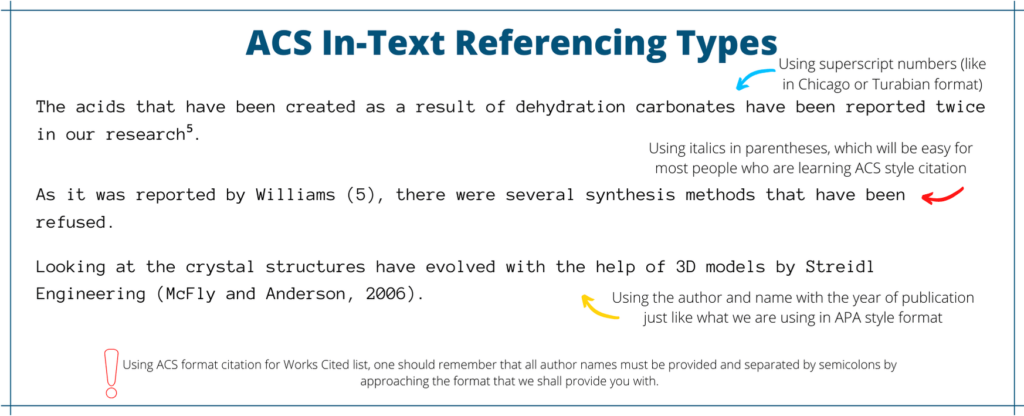ACS Citation Generator With Guide to Get Your Chemistry References Ready

Are you sure you want to delete all the citations in this list?
Tips to use the citation generator
Choose the citation style
Follow your professor's guidelines or consult your university's website.
Doublecheck the source
Ensure correct rules for different sources like websites, articles, books. Edit or manually create citations if required.
Check the citation fields
Verify the automatically filled fields with your source. Make edits as needed.
Generate your citation
Confirm style, source, and fields, then generate your citation. Don't forget to create and download your paper's reference list.
What is ACS Citation Format?
We all know quite a bit about MLA or APA style writing formats, yet those students who study Chemistry, Nursing, Medical Biology, or Pharmacology are facing the challenges of ACS citations. As you might have already guessed, it stands for American Chemical Society citation format. Currently in its third edition (published in 2006), as offered by the ACS Style Guide, it is mostly used for all kinds of academic writing that deals with Chemistry. It must be noted that this format is not among those that are overly challenging, yet some rules must be remembered. However, some Chemistry students find it impossible to get right, which is why our ACS reference generator becomes the only possibility to avoid getting bad grades for incorrect citing.
The Information You Should Provide For Your ACS Citation
First of all, we must focus on how to cite your quotes inside of some text content. Here are some rules that will help you understand how everything works. It is recommended to cite your in-text references in one of three ways:
- Using superscript numbers (like in Chicago or Turabian format), which will look like this:
- Using italics in parentheses, which will be easy for most people who are learning ACS style citation:
- Using the author and name with the year of publication just like what we are using in APA style format:
Using ACS format citation for Works Cited list, one should remember that all author names must be provided and separated by semicolons by approaching the format that we shall provide you with.
Discover ACS Referencing Examples
As you remember, we have already reviewed the basic rules for in-text ACS citing, which is why we shall start with the template for our Works Cited page. Here are real-life ACS citation format examples to help you follow along:
- Books in Print:
- Electronic Book:
- Chemistry Encyclopedias:
- Scientific Journal ACS Reference Publication:
- ACS Style Web Citation:
As you can see, you should mark the names of scientific journals and the book titles in italics. When working with DOI reference, the title is not placed in italics. As for the other citation types, they are mostly following the same pattern. We recommend saving some time and nerves by using our free ACS citation maker.
How to Cite Using ACS Citation Machine
Our citation tool works in a simple way that won’t take too much time even if you are planning to work in the manual mode. What it means is entering the required information in relevant fields by choosing your target reference type. It can be a print book, an electronic source, some magazine, a web page, or even something coming from some multimedia resource. Depending on what you choose, the fields that you must fill will change accordingly. At the same time, you can choose our automatic creator mode, which will let you enter your book’s title, ISBN, or name of the author to let our ACS citation machine find your source.
It works as a great time-saver and will help you to avoid any plagiarism risks. Once you are ready to generate your citation, you will receive an already formatted citation for your Works Cited page and the in-text citation as well. You can also download or copy your final citation in MS Word format, which will help you to download the ACS template.
The Features of Our ACS Generator
Most importantly, you do not have to pay anything when you use our ACS citation tool for your Chemistry homework. Take a quick look at some features that make it stand out:
- No registration and limitations of any kind, which means that you can cite as much as you wish.
- Automatic and manual ACS citation generator modes that let you avoid plagiarism.
- Cite your sources by entering ISBN, author’s name, journal’s DOI, or the URL.
- You can choose any citation type maker from a book in print to a webpage source.
Just give it a try and see how much easier it becomes!
Why Should I Use an ACS Citation Generator?
You will not have your final paper degraded because of a minor formatting mistake. Your citations will be clear without typos or extra unnecessary spaces. If you have over 10 sources for your Chemistry project, you just have to enter your book’s ISBN or titles to get everything up and ready in about five minutes. Do not forget that it is free!
FAQ
✍️ Can I use any in-text citation style in ACS? Will my Works Cited page change?
Yes, you can implement superscript numbers (but then add them in your Works Cited page accordingly before the author’s names in a correct order as it is met in text) or turn to the usual in-text Last Name – Date patterns.
✍️ How to cite more than two authors in the text?
Just provide surnames of both authors with “and” part in between with a comma and the year (Jones and Kelly, 2009) or use our citation machine ACS for making it faster.
✍️ How to cite patents in ACS style?
Sharon, S. C. Energetic Low-Key Resonator Pressure Generator. U.S. Patent 2,237,991, June 19, 1986.


